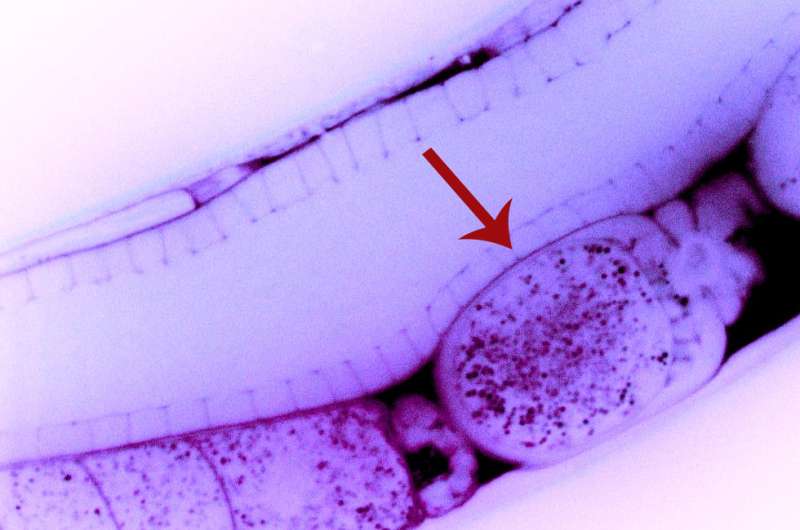Biologists first to observe direct inheritance of gene-silencing RNA

The basics of genetic inheritance are well known: parents each pass half of their DNA to their offspring during reproduction. This genetic recipe is thought to contain all of the information that a new organism needs to build and operate its body.
But recent research has shown that, in some species, parents' life experiences can alter their offspring. Being underfed, exposed to toxins or stricken by disease can cause changes in a parent's gene expression patterns, and in some cases, these changes can be passed down to the next generation. However, the mechanisms that cause this effect—known as non-genetic inheritance—are a mystery.
New research from the University of Maryland provides a surprising possible explanation. For the first time, developmental biologists have observed molecules of double-stranded RNA (dsRNA)—a close cousin of DNA that can silence genes within cells—being passed directly from parent to offspring in the roundworm Caenorhabditis elegans. Importantly, the gene silencing effect created by dsRNA molecules in parents also persisted in their offspring.
The work, published October 17, 2016 in the online early edition of the Proceedings of the National Academy of Sciences, suggests that the mechanisms for non-genetic inheritance might be simpler than anyone had suspected.
"This is the first time we've seen a dsRNA molecule passing from one generation to the next," said Antony Jose, an assistant professor in the UMD Department of Cell Biology and Molecular Genetics and senior author on the study. "The assumption has been that dsRNA changes the parent's genetic material and this altered genetic material is transmitted to the next generation. But our observations suggest that RNA is cutting out the middle man."
Jose and his team, including graduate student and lead author Julia Marré and former research technician Edward Traver, introduced dsRNA marked with a fluorescent label into the circulatory system of C. elegans worms. They then watched as these fluorescent RNA molecules physically moved from the parent's circulatory system into an egg cell waiting to be fertilized.
In a surprising turn of events, some of the dsRNA molecules could not silence genes in the parent because the dsRNA sequence did not match any of the parent's genes. But the dsRNA molecules did silence genes in the offspring, when the new worm gained a copy of the matching gene from its other parent. This suggests that, in some cases, gene silencing by dsRNA might be able to skip an entire generation.
"It's shocking that we can see dsRNA cross generational boundaries. Our results provide a concrete mechanism for how the environment in one generation could affect the next generation," Jose said. "But it's doubly surprising to see that a parent can transmit the information to silence a gene it doesn't have."
Jose and his colleagues did not expect dsRNA to play such a direct role in the transmission of information across generations. Because dsRNA factors into the life cycle of many viruses, Jose explained, it is reasonable to assume that a living cell's natural defenses would prevent dsRNA from invading the next generation.
"It's very surprising. One would think the next generation would be protected, but we are seeing all of these dsRNA molecules being dumped into the next generation," Jose added. "Egg cells use the same mechanism to absorb nutrients as they prepare for fertilization. The next generation is not only getting nutrition, it's also getting information."
Jose and his colleagues hope to learn more about the precise mechanisms by which dsRNA silences genes across multiple generations.
"There are hints that similar things could be happening in humans. We know that RNA exists in the human bloodstream. But, we don't know where the RNA molecules are coming from, where they're going or exactly what they're doing," Jose said. "Our work reveals an exciting possibility—they could be messages from parents to their offspring."
More information: Extracellular RNA is transported from one generation to the next in Caenorhabditis elegans,PNAS, www.pnas.org/cgi/doi/10.1073/pnas.1608959113
Journal information: Proceedings of the National Academy of Sciences
Provided by University of Maryland



















